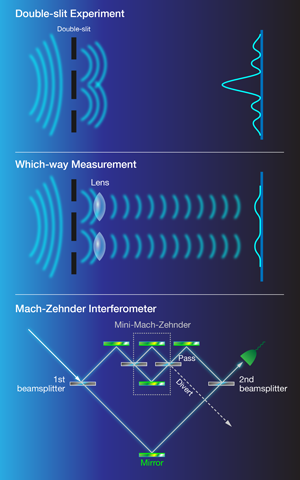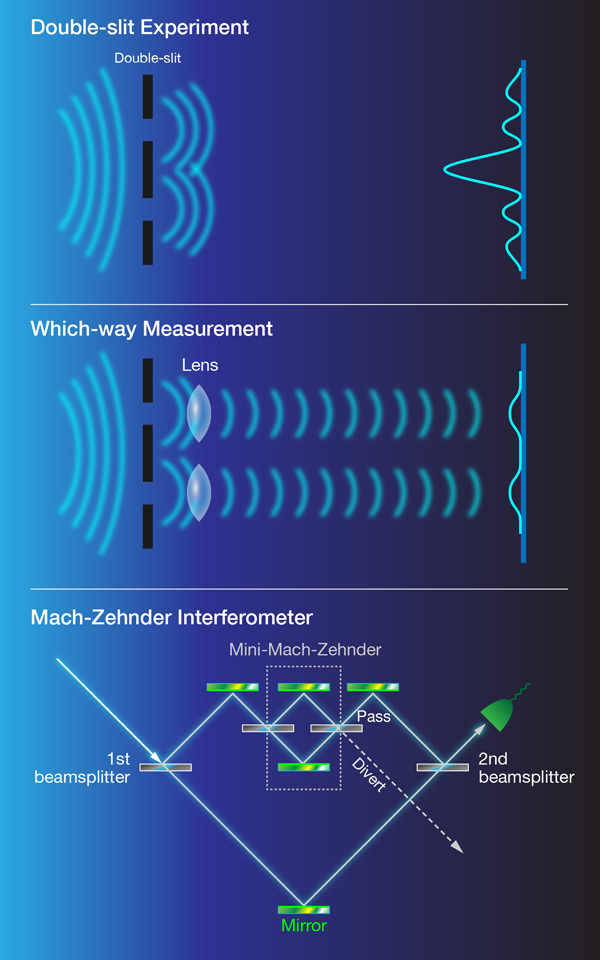What Can we Say about a Photon’s Past?
Quantum theory provides the foundation for much of the technology of modern society. And yet, physicists are still not sure how to think about some of its underlying concepts. One of these is the history of a quantum particle: when we measure an electron or photon in a detector, we can’t be sure of what trajectory it took to get there from the source. Whereas a classical particle traveling between two points always has a single trajectory as its history (think of a cannonball), the history of a quantum particle arriving at a detector is made up of every path it could have taken from where it started. Writing in Physical Review Letters, Ariel Danan and colleagues at Tel-Aviv University, Israel, present a modern version of the famous double-slit experiment with light that underscores how difficult it is to know a quantum particle’s past [1]. They show that even when their experiment blocks light from taking certain paths to a detector, these forbidden paths still appear to be part of the photons’ history.
In the double-slit interference experiment (Fig. 1, top), a beam of photons impinges on two closely spaced slits. A light-sensitive screen placed on the opposite side of the slits will reveal a pattern due to the wavelike interference between the two possible paths—top slit or bottom slit—the photon can take to any point on the screen. But which slit did the photon travel through on its way to the screen? Two common answers are “both slits” and “one cannot say,” but either way, the photon’s trajectory (its history) is ambiguous.
One can try to find which path a photon takes by inserting a lens after each slit—the idea being that each lens will only collimate those photons arriving from its respective slit. In this “which-way” measurement [2], the interference pattern on the screen should disappear and be replaced by two distinct spots, one for each slit (Fig. 1, middle). It would then seem safe to assume that a photon detected in, say, the upper spot, must have taken the route through the upper slit. That is, it appears that there is no confusion in this case: the photon had a single trajectory as its history.
The Tel-Aviv experiment calls even this seemingly safe assertion into question. Danan et al. use a Mach-Zehnder interferometer (MZI), in which the two output ports of a beam splitter—the reflection path and the transmission path—take the place of the two slits (Fig. 1, bottom). These two outputs lead to an upper and lower arm, which recombine the photons at a second beam splitter. They set up the path lengths of the two arms so that their outputs interfere constructively, ensuring that all photons exit the second beam splitter in the same direction. Instead of asking “which slit?” the photon travels through, the authors ask “which arm?”
The authors probe where the photons were in two situations: when there is interference and when there is a “which-way” measurement. To label the particular path of the photon, i.e., whether it went via the upper or lower arm, the authors insert in each arm a mirror whose vertical tilt vibrates at a unique frequency. The vibrating mirror deflects the beam up and down but only by a small amount so as to not disturb the interference. Then, the authors monitor the frequency spectrum of the vertical position of the photons exiting the second beam splitter. If the spectrum contains the same frequency as that of the vibrating mirror in, say, the upper arm of the interferometer, this suggests some of the photons traveled down that arm (and similarly for the lower arm.) And indeed, when the beam splitter that combines light from the upper and lower arms is in place, two frequencies are observed, suggesting photons traveled through both arms. Removing this beam splitter functions as a which-way measurement; only light from the lower arm reaches the detector. In this case Danan et al. only see the frequency associated with the lower arm. The photon had definitely traveled along a single trajectory: through the lower arm to the detector.
But Danan et al. see a surprising effect when they then insert a mini-MZI in the upper arm. In this more complex setup, photons pass from the upper arm to the second beam splitter only when the mini-MZI is set for constructive interference, while deconstructive interference diverts this light. In this way, the mini-MZI lets the experimentalists switch between observing interference between light that traveled in the upper and lower arms of the large MZI and observing only that light that traveled through the lower arm. The researchers additionally now vibrate all the mirrors in the upper arm—the ones before, inside, and after the mini-MZI.
With the mini-MZI set to pass light, the researchers observe frequencies corresponding to every path through the system to the detector. That is, the photons had no unique trajectory, much like in the double-slit experiment. But by setting the mini-MZI to divert light exiting the upper arm, the authors are again able to perform a which-way measurement. As before, they see the lower arm frequency. The problem is they also see frequencies from both of the arms inside the mini-MZI, a perplexing observation for two reasons. First, it implies the photons reaching the detector traveled down a path (the upper arm) that should never have reached the detector. Second, they don’t see the frequencies from the mirrors just before and after the mini-MZI in the upper arm, so it’s as though the photons in the upper arm passed through the mini-MZI but never entered or exited it.
At face value, the authors’ experimental results imply that even when it seems a particle must have followed a certain trajectory, we can’t rule out other paths. For example, even with the lenses in place in the double-slit experiment, it may be wrong to claim that the photon came from, say, the left slit. One possibility is that lenses are okay but the mini-MZI is not, but this seems unlikely, since propagation through a lens is, like propagation through a MZI, a type of interference. And changing a phase at the lens can re-overlap the path from each slit so that interference can be observed at the screen. Thus the Tel Aviv work has potential implications for many which-way devices, particularly for the complicated ones used in delayed-choice experiments [3].
Some have argued that there is a shortcoming in Danon et al.’s measurement procedure [4]. Namely, even though the labeling vibrations are small, they are sufficient to disrupt the interference in the mini-MZI. Thus, even if the mini-MZI is set to have deconstructive interference (i.e., set to “divert”), it will still allow a tiny number of photons to pass to the second beam splitter. But Danan et al. argue that another explanation is simpler (and thus better): one should consider not just the possible paths of the photons traveling forwards through the system but also the paths that a photon traveling backwards from the detector could take, an idea captured by what is called the two-state vector formalism [5]. The locations where these forwards and backwards paths coincide will have its corresponding frequency appear in the detected spectrum [6].
As an experimental physicist, I find it almost impossible to build a setup without having a mental picture of the trajectory photons travel along from one point to another; how else can I know where to put mirrors or lenses? Yet, as Feynman discussed [7], a quantum particle takes every possible path through space from one point to another. Hence a particle’s propagation or evolution is reminiscent of a multipath interferometer, and, as Danan et al.’s experiments show, its final state carries the imprint of all possible paths.
References
- A. Danan, D. Farfurnik, S. Bar-Ad, and L. Vaidman, “Asking Photons Where They Have Been,” Phys. Rev. Lett. 111, 240402 (2013)
- N. Bohr, in Albert Einstein: Philosopher-Scientist, edited by P. A. Schilpp (Library of Living Philosophers, Evanston, 1949); reprinted in Quantum Theory and Measurement, edited by J. A. Wheeler and W. H. Zurek (Princeton University Press, Princeton, 1983)[Amazon][WorldCat]
- A. Peruzzo, P. Shadbolt, N. Brunner, S. Popescu, and J. L. O’Brien, “A Quantum Delayed-Choice Experiment,” Science 338, 634 (2012)
- Z.-H. Li, M. Al-Amri, and M. Suhail Zubairy, “Comment on ‘Past of a Quantum Particle’,” Phys. Rev. A 88, 046102 (2013)
- Y. Aharonov, P. G. Bergmann, and J. L. Lebowitz, “Time Symmetry in the Quantum Process of Measurement,” Phys. Rev. 134, B1410 (1964)
- Y. Aharonov, D. Z. Albert, and L. Vaidman, “How the Result of a Measurement of a Component of the Spin of a Spin-1/2 Particle Can Turn Out to Be 100,” Phys. Rev. Lett. 60, 1351 (1988)
- R. Feynman, QED: The strange theory of light and matter (Princeton University Press, Princeton, 2006)[Amazon][WorldCat]





